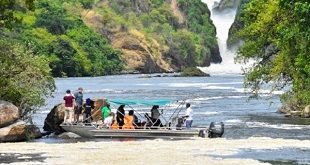New threats in Queen Elizabeth National Park?
But while it’s common for the elephants to cross borders, in the past decades, the elephants have tended to move more from Virunga to Queen Elizabeth National Park and stayed in Uganda permanently to, presumably, escape the restive eastern DR Congo which is the base for several fighting groups of rebels, government forces, and poachers.
For the four years Edward Asalu worked in Queen Elizabeth National Park as chief warden, he only observed elephants move from Congo to Uganda due to insecurity.
“If the elephants are going the other side, I am not sure what could be happening in Queen Elizabeth National Park because as far as I am concerned, the fighting groups (insurgents) in Congo are still there. This is something we need to investigate,” Asalu told The Independent on Jan.25.
In April, last year, for instance, 12 Virunga Park rangers, a driver and four members of the local community lost their lives in a ferociously violent attack by a militia group, the deadliest known attack on park rangers on the African continent in recent history.
On Jan. 10, this year, six park rangers who were patrolling on foot were killed in an early morning ambush by armed assailants. These are threats that elephants do not take lightly and often flee to safety in Uganda.
That is possibly why some sources told The Independent that the exodus of elephants from Uganda could be a signal that they are under a yet unidentified threat in Queen Elizabeth National Park.
Some say the migration started during the COVID-19 lockdown, a period which also coincided with an uptick in poaching in most of Uganda’s conservancies. But others ruled out poaching out rightly.
Poaching in Uganda’s national parks, for instance, doubled during the lockdown compared with the same period in 2019 according to the Uganda Wildlife Authority. The conservation agency recorded up to 367 poaching cases across Uganda’s conservancies between February and June 2020, more than the 163 cases UWA recorded in the same period in 2019.
But Odokorwot told The Independent that he doubts poaching could be the reason considering that Queen Elizabeth National Park is at its most tranquil moment. “Even at the height of the Tito Okello regime (mid-1980s) and the ADF rebel incursion in the park, we did not see this kind of migration; it is the security that propels the elephants to move along their migratory path.” Odokorwot insists this kind of movement is seasonal and believes the elephants will come back to Queen Elizabeth National Park.
Nampindo suggested a couple of factors that could be responsible for the exodus of the elephants. He said the combined effect of poaching, livestock grazing, invasive species and fires, which are key threats to Queen Elizabeth National Park, cannot be underestimated.
He said the rapid increase in invasive plant species that have occupied the suitable habitat areas for elephants has led to loss of suitable food resources for the elephants.
“We have analysed the invasive species threat with reference to the core lion conservation areas and other large mammals in Queen Elizabeth National Park and no wonder the elephants together with some antelopes are moving to Virunga.”
Nampindo told The Independent that his team has mapped the vegetation changes in Queen Elizabeth National Park and noted that for the entire landscape; there was a 14% increase in woody cover between 2006 and 2017 and a reduction in grasslands, which is a slightly higher rate of loss over 11 years compared to the period of 52 years.
They also mapped the fire occurrence between 2004‐2009, and 2012‐2017 and noted that there was more frequent burning of larger areas in the latter period although there were more dry season periods between 2004‐2009 (10 dry seasons) compared with 2012‐2017 (10 dry seasons). This observed trend is what would be expected due to the increase in rainfall and biomass production.
While control of fires in Virunga Park has been impossible in recent years due to the presence of armed rebels, the Uganda Wildlife Authority has been trying to control fire frequency in Queen Elizabeth Protected Area; however, fire mapping results showed that this has not always been successful.
This is mainly because poachers deliberately set fires to encourage animals to come close to their villages without risking entering the park illegally.
Thus, vegetation change mainly attributed to a combination of climate change and natural ecological processes has reduced some of the core habitat areas for elephants in Queen Elizabeth National Park, replacing the favourable plant species with unpalatable, invasive plant species potentially sending the elephants on a long search for food elsewhere.
The other factor Nampindo suggests could be the recent erecting of an electric fence around the Kyambura Wildlife Reserve in Uganda and another along the border of Virunga NP and Ishasha sector of Queen Elizabeth National Park.
Nampindo also told The Independent that although his team is yet to conduct a specific study to assess the effect of the frontier fencing; it could be one of the candidate explanations or contributing factor to the elephant movement in response to, and avoidance of the fence, particularly, if they have been experiencing electric shocks.
Conservationists who are familiar with elephant behaviour say elephants quickly adapt to their territory and learn to avoid obstacles to their movement. However, due to the high developed memory part of their brain, elephants maintain and retrace their movement routes over several generations.
“We have learned from the long term monitoring of elephants in Murchison Falls National Park that elephants respond to human disturbances with a reasonable intensity of sound and light and can move away covering a distance of 5‐10 km and keep in new areas for months until they detect normality in their core and suitable areas.”
Nampindo told The Independent that if nothing dramatically disturbs the peace of elephants in Virunga, they are expected to stay there for sometime only to return when food resources become limiting.
But he has also ruled out poaching being the reason for their exodus to Virunga. “We know that the killing of one or two elephants by poachers in a period of one year cannot cause such mass movement of elephants at once.”
“The hunting has to be relatively high in order to trigger such mass movement of elephants. In this case, it would have raised immediate attention from conservation organizations as well as local communities and security and law enforcement institutions of Uganda, particularly UWA and the UPDF.”
Mysterious trigger
“Elephant movement in this landscape is normal and expected to happen with or without human interference. It is premature for us to pin down the exact trigger for elephant movement from Queen Elizabeth National Park to Virunga National Park without conducting research and monitoring on both sides of the parks,” Nampindo said.
Meanwhile, Space for Giants; a Nairobi-based conservation agency which has been working with UWA to erect electric fences in sections of Queen Elizabeth Park to control elephant movement into the frontline communities told The Independent in an email that in their two decades’ work of installing electric fences and studying elephants, they have not seen elephants so affected by interacting with a fence that they leave the area permanently or semi-permanently.
“These are sophisticated fences that deliver non-lethal shocks that deter animals but do no long-lasting harm,” said Dr. Lauren Evans, Space for Giants’ Director of Conservation Science and a leading expert on elephant interactions with fences.
“Space for Giants continues to work in partnership with, and under a mandate from, the Uganda Wildlife Authority as it works to refine and expand a comprehensive national strategy to reduce human-elephant conflict.”
Evans told The Independent that Space for Giants is thrilled to see the efforts of the Uganda Wildlife Authority, the ICCN in DR Congo, and all the conservation partners involved, succeed to the point where elephants are migrating across this landscape into Virunga once again.
“This has happened because of the hard work to keep corridors open, and to make Virunga safe. It has not happened because elephants are leaving Queen Elizabeth National Park after being shocked by electric fences that UWA has installed in close partnership with Space for Giants,” Evans said.
Some conservationists say the recent migration of the elephants to Virunga could in fact be the result of the park’s recent and critical conservation efforts in its central savanna. One of these is Emmanuel De Merode, the director of Virunga National Park.
“The return of large elephant herds to Virunga is the outcome of decades of extraordinary efforts on the part of Congo’s park rangers,” he said.
****
 The Independent Uganda: You get the Truth we Pay the Price
The Independent Uganda: You get the Truth we Pay the Price



Thank you Mr. Musoke and The Independent for this fascinating and wide-ranging article.
We at Space for Giants would wish only to make one small comment. Dr. Nampindo, among his insightful and learned remarks, suggests that there is “an electric fence around the Kyambura Wildlife Reserve in Uganda and another along the border of Virunga NP and Ishasha sector of Queen Elizabeth National Park”.
With great respect, we must report that this confuses the location of the fences that UWA with Space for Giants support has installed. At Kyambura Wildlife Reserve, the fence runs along the border of the Reserve, it does not go around it. It is 19.5km long, not 10km. This fence is at a significant distance from Virunga/the DR Congo border. There is no fence “along the border of Virunga NP”, only plans for one UWA wants to build. There is also no fence at “Ishasha sector”, again only plans for one that UWA wants to build. This point is important because as the report stands, it might be read to suggest that elephants habitually in the parts of QENP near to Virunga have moved to Virunga because of being shocked by electric fences, that can’t be the case as *there are no electric fences in those parts of QENP*.
Elephants do migrate far, so it’s feasible they might move from areas where there are fences all the way to Virunga, but to do so they need to cross significant areas of dense human habitation. That is unlikely for hundreds of elephants to be able to do.
There are two fences UWA has built with Space for Giants support. One running for 22.8km from Kasese town to the south, and the other mentioned above running 19.5km along the Kyambura WR border. Both are significant distances from the border with Virunga.
We trust that this comment will detract in no way from what is a very well researched and illuminating article into a fascinating topic. Again, thank you.
Space for Giants.
Suppose these beast do not return, what will become of our Queen Elizabeth National Park and how can we make claim on them?
In other words, it is high time these beast are electronically tagged so that we may know wherever they go back and forth, and dead or still alive.
Their major risk is that: in the volatile Eastern DR Congo (Failed State), they will be poached for their tasks (ivory) by all the different rebel groups in that part of the wilderness.
Hmmm, we know animals have a sense of impending geological catastrophes. Could this be the case here ? Remember the area in question is a geologically active area
“Zikusoka’s junior colleague, Walter Odokorwot who is the coordinator of the Human-Wildlife Conflict management programme at CTPH, agrees. He has worked in the area for 27 years and knows a thing about elephant behaviour.”
Someone who has worked in the area for 27 years cannot be called a “junior colleague”.